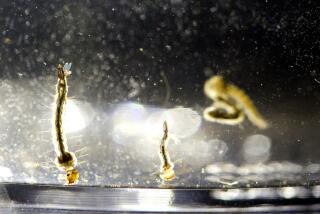Genetically Engineered Organisms Not Dangerous, Science Panel Finds
WASHINGTON — Organisms produced by genetic engineering techniques are fundamentally no different from those produced by conventional cross-breeding and are “not inherently dangerous,” according to a report issued Wednesday by a special committee of the National Academy of Sciences.
For tests of some microorganisms that have a potential to threaten the environment, the committee recommended introduction of a “suicide gene” that would cause the mutated bacteria or virus to self-destruct after the test.
But overall, there is no need for a major revision of existing rules governing the release of genetically engineered organisms into the environment, the committee said.
Instead, the decision to release engineered plants, bacteria and viruses into the environment “should focus on the characteristics of the plant or microorganism itself, not the techniques used to create it,” said biochemist Robert H. Burris of the University of Wisconsin, chairman of the panel.
Engineered plants are especially safe, the committee said, because they “rarely, if ever, escape to cause problems in the natural ecosystem.” Release of microorganisms requires more study, but “no adverse effects have developed” from such introductions in the past, according to the report.
Since the techniques of genetic engineering were first developed 15 years ago, controversy about the potential danger has surrounded it. Critics have charged that mutated bacteria or plants released into the environment during tests could escape and produce an ecological disaster. The new report seems to discount those objections.
But activist Jeremy Rifkin of the Foundation on Economic Trends, a long-time opponent of genetic engineering, attacked the report as “irresponsible public policy,” charging that the committee was motivated by “politics, not science.”
To date, the U.S. Department of Agriculture and the Environmental Protection Agency have issued about 80 permits for field testing of engineered organisms, most of them plants. But officials expect much larger numbers of applications in the future because of the great potential of genetically engineered organisms.
Applications currently being pursued include bacteria that would degrade environmental pollutants and extract metals from ores, food plants that would flourish under dry or salty conditions, viruses that would control insect pests and crops that would resist weed killers and pests and, eventually, produce their own fertilizer.
The panel was created last year by the academy at the request of federal regulatory agencies to determine whether new rules should be developed for evaluating the growing number of applications.
The panel noted that “society has benefited greatly from the use of genetically modified microorganisms and plants” and that field testing of new species “is essential” for the development of still better species.
The testing of genetically engineered plants, they concluded, is particularly hazard free because scientists have already tested “hundreds of millions of genotypes . . . over decades” with no adverse effects.
The report said genetically engineered plants may be safer than those produced by cross-breeding because the gene transfer is more precise.
“The (genetic) techniques are . . . more predictable than the classical methods,” Burris said at a Washington press conference.
Critics have argued that the biggest risk of field testing such plants is that they will escape and become weeds. But the committee concluded that the physiological characteristics that enable plants to thrive as weeds have been bred out of the crop species that researchers are experimenting on so that there is little risk that such plants could survive if they escaped from test plots.
Hence, there is no need to change the way such experimental tests are evaluated, the committee concluded.
“The laws as they exist now are adequate for this,” said panel member Edward L. Korwek of the Washington-based law firm of Hogan & Hartson.
Researchers have less experience with microorganisms, the panel said, but ecological uncertainties can be addressed by considering the changed properties of the microorganisms, in addition to such environmental considerations as nutrient availability.
In particular, the panel concluded that the fear of creating hazardous microorganisms, or pathogens, is overstated.
Thomas H. Maugh II reported from Los Angeles and Kevin Davis from Washington






